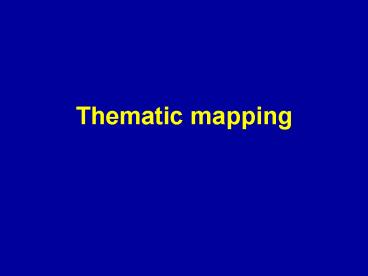Thematic mapping - PowerPoint PPT Presentation
1 / 24
Title:
Thematic mapping
Description:
symbolization - displacement - smoothing - enhancement. Two general types of maps ... show 'geographical concepts' such as population density, climate, movement ... – PowerPoint PPT presentation
Number of Views:1272
Avg rating:3.0/5.0
Title: Thematic mapping
1
Thematic mapping
2
Cartographic abstraction
- Map production requires- selection-
classification- simplification- exaggeration-
symbolization- displacement- smoothing-
enhancement
3
Two general types of maps
- Topographic maps- show outlines of selected
natural and man-made features- often serves as
frame of reference - Thematic maps- show geographical concepts such
as population density, climate, movement of goods
4
Choropleth maps
- uses reporting zones such as districts
- shows data such as average income,mortality
rates, or percentages - boundaries of the zones are established
independently of the data - zones may be used to present many types of data
5
Choropleth maps
Total Fertility Rate
PopulationDensity
6
Choropleth maps
Philippines Population Density by Province
7
Choropleth maps
- equal intervals 0 - 10 10 - 20 20 - 30 30 -
40
8
Choropleth maps
- equal number of cases(quantile mapping)- same
number of observations in each class-
problem if there are many similar values -gt
cases with the same value may be put into
different classes
9
Problems with quantile mapping
7
6
risk index
2
1
6
12
18
24
rank order
Risk index values in rank order with the
resulting class break points indicated
Map of risk indices using adjusted quantile
classes
0.7 - 6.6
0.3 - 0.6
0.1 - 0.2
0.0
Source MacEachren (1994)
10
Choropleth maps
- often useful to plot a histogram of the data
before determining class breaks
11
Area class maps
- shows zones of constant attributes such as
vegetation or soil classes - zones are different for each map because they are
dependent on the feature mapped - e.g., boundaries between vegetation types are
different from those for soils
12
Area class maps
Vegetation Classes
Soil Categories
13
Isopleth maps
- shows an imaginary surface by means of lines
joining locations of constant value called
isolinese.g., elevation contours - used for phenomena which vary smoothly such as
temperature, pressure or sometimes population
density
14
Isopleth map
Mean annual rainfall
15
Dot density maps
- represents the magnitude of a variable by varying
the density of dots within each area - popular for population applications
16
De Montizons Population Dot Map of 1830
17
Graduated symbol maps
- size of a symbol represents the magnitude of a
variable - often appropriate for socioeconomic variables
- can use a symbol or icon that represents the
variable
18
Number of telephones per 1000 people
10
(
(
25
(
50
(
(
(
(
100
(
(
(
(
(
(
(
(
(
(
(
(
(
(
(
(
(
(
19
Flow maps
- width of a bar or arrow is proportional to the
corresponding flow - direction shows from where to where the flow
occurs - few mapping packages implement this feature
20
Where do people migrate tofrom this district?
net migration
1000
5000
10000
21
Thematic mapping
- design issues
- data need to be represented correctly and in an
easy-to-understand way - choice of colors, symbols, fonts, etc. needs to
be matched to the variable mapped
22
Graphic variables for points, lines and areas
areas
line
point
hue
size
focus
value
shape
texture
saturation
orientation
arrangement
Source MacEachren (1995) after DiBiase (1991)
and Bertin (1983)
23
Matching data types to cartographic
representations
abrupt
smooth
discrete
continuous
24
Thematic mapping
- desktop mapping and GIS packages offer
increasingly sophisticated thematic mapping tools - still, many cartographers prefer to export a map
from the GIS and do the final design in a
high-end graphics package like CorelDraw or Adobe
Illustrator































